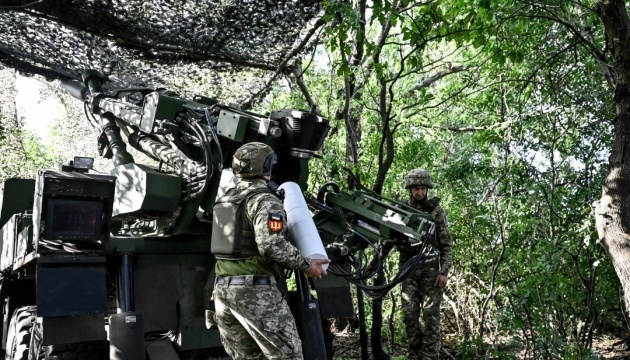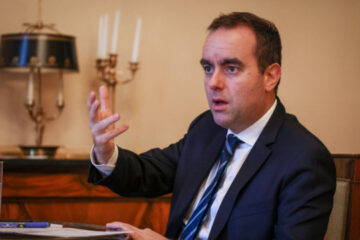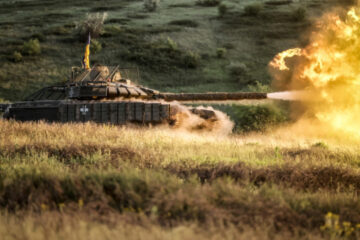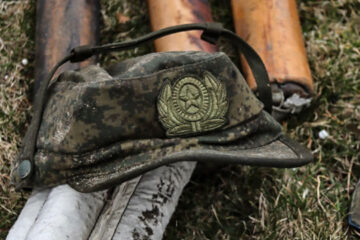Rada has passed tax-raising law. The Ukrainian military struck an ammunition storage site at Khanskaya military airfield in Russia’s Adygeya region, hit oil depots in several different regions in Russia. Ukrainian forces won back part of their lost positions in Russia’s Kursk region
MAIN EVENTS OF THE WEEK
October 6: A new batch of F-16 fighter jets arrived in Ukraine from the Netherlands, with 24 more expected for delivery in the coming months.
A summit of allied countries aimed at coordinating more military support for Ukraine set for Saturday, due October 12, has been postponed following the cancellation U.S. President Joe Biden’s visit to Germany. At the end of a three-day trip to Germany, Biden was due to chair a meeting of the Ukraine Defense Contact Group, otherwise known as Ramstein Format. The Ukraine Defense Contact Group coordinates military support for Kyiv, and is a critical platform for discussing the ramp up in supplies of air defense systems and ammunition to Ukraine. However, as Hurricane Milton bears down on the Florida coast this week the White Huse announced that Biden’s trip to Germany wouldn’t happen. At Ramstein, President Biden had been scheduled to host a summit on the war in Ukraine. Ukraine’s President Volodymyr Zelensky was also set to present his Victory Plan at Ramstein with the hope of securing more military support. Biden had postponed the trip due on 8 October and remained in Washington, DC to monitor Hurricane Milton’s impact on Florida. Biden’s trip has been tentatively rescheduled for next Friday, October 18.
COMMENT. Oleksandr Yusupov, international affairs analyst: “I believe that there is a coincidence of two factors – one is the strongest hurricane ever recorded in the US history, the other being the approaching presidential election. That’s why they chose to postpone the meeting. Holding it with Blinken as the chair or via a video conference would be inappropriate, given that the agreement was to hold the meeting at the summit level. Furthermore, the meeting was supposed to have discussed issues of the highest importance, specifically, more explicit actions regarding Ukraine’s accession to NATO.”
France plans to transfer between 12 and 20 Mirage 2000 fighter jets, which are set to all be delivered in the first quarter of 2025. French Minister of the Armed Forces Sebastien Lecornu has announced that the second-hand fighters will receive a number of upgrades before delivery, including the integration of new electronic self-defence systems that will facilitate more effective air to surface operations.
Rome will host the next Ukraine Recovery Conference on July 10-11, 2025, Italian Prime Minister Giorgia Meloni announced on Thursday following discussions with Ukrainian President Volodymyr Zelensky. Meloni affirmed Italy’s support for Ukraine, emphasising continued solidarity in the country’s reconstruction efforts. Previous conferences took place in Switzerland, the UK and Germany.
The World Bank’s executive board on Thursday approved the creation of a financial intermediary fund (FIF) worth $10 billion to support Ukraine, with contributions expected from the United States, Canada and Japan. The fund, to be administered by the World Bank, will help fulfill a pledge by Group of Seven rich democracies to provide Ukraine with up to $50 billion in additional funding by the end of the year.
THE WAR AS IT IS
October 7/ Horbach: Volunteers will be able to be recruited for military service bypassing military enlistment authorities
[embedded content]
October 7/ Interview. Victory Commanders. Yuri “Achilles” Fedorenko: Parity with Russian forces in UAVs, destroyed enemy equipment, Kursk incursion, war conscription
[embedded content]
October 9/ Interview. Oleksandr Novoselsky, “Station Kramatorsk”: It is machines which are supposed to fight; solders’ lives must be saved
[embedded content]
October 10/ Shorts. Novoselsky: Ukraine can manufacture drones that will rival Taiwanese or Chinese ones in quality
[embedded content]
October 8/ A high-rise apartment building in Chornomorsk, Odesa oblast, was damaged in an overnight attack with Russian launched Shahed drones
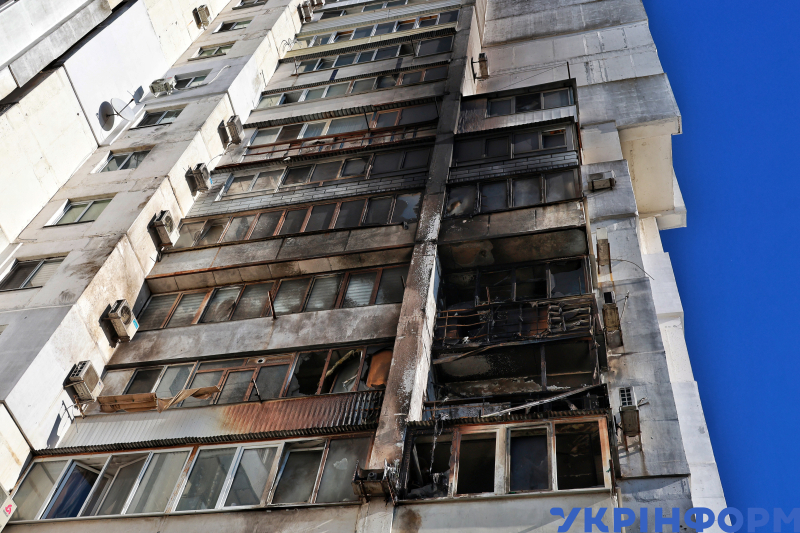
October 9/ Artillery gun crew working on a defensive position at the Kharkiv front
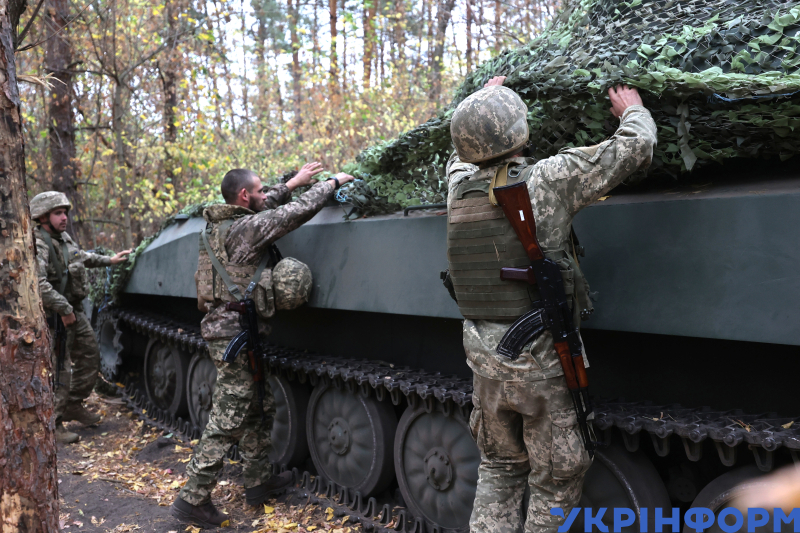
October 9/ Military section of the Pivdenne Cemetery, Kyiv
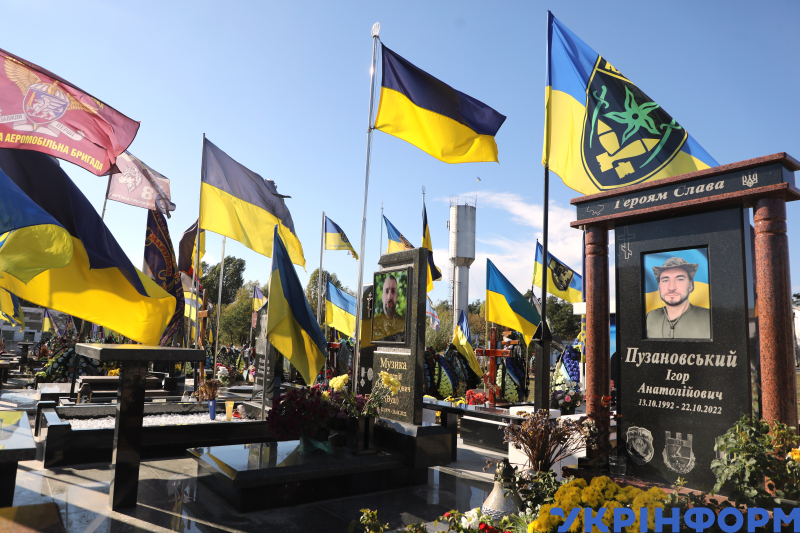
October 11/ Memorial ceremony, Kyiv, for the Ukrainian journalist Victoria Roschyna, who died in Russian captivity
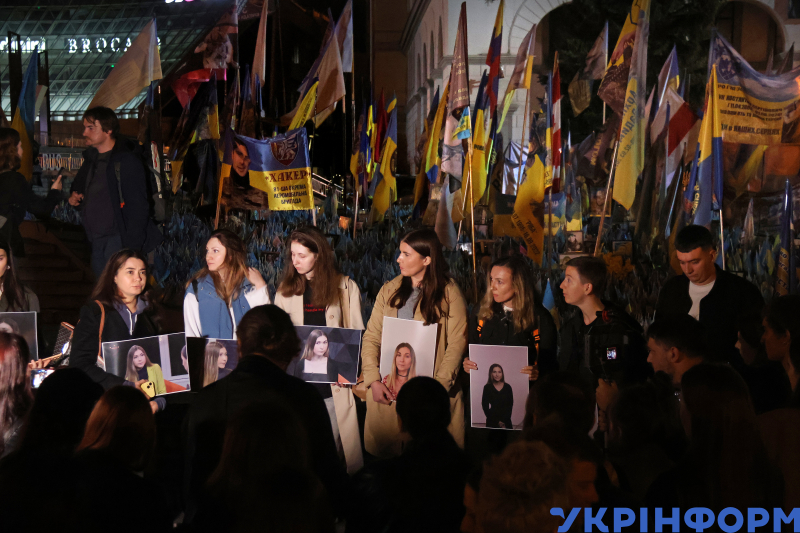
THE BATTLEFIELDS
Armed Forces Supreme Commander:
October 7: visited the Armed Forces Territorial Defense Forces command-and-control center, listened to a report from the Territorial Defense Forces Commander Ihor Plahuta, focusing on the tasks Territorial Defense Forces brigades are performing in the war zone
October 8: hosted a meeting at the Supreme Commander’s Headquarters addressing, among other issues, weapons and military equipment provisions for the Defense Forces
***
Ukrainian attacks on the Russian Federation and Russia occupied Ukraine
October 7: A major fuel storage facility in Crimea had been burning for three days following a successful Ukrainian drone strike overnight on October 7, severely impacting the region’s energy infrastructure. The attack targeted the largest oil terminal in the port city of Feodosia, a critical asset for Russian military operations. According to the Armed Forces General Staff, its forces launched the strike, which led to a series of explosions and widespread damage at the Feodosia Marine Oil Terminal in southeastern Crimea. The attack reportedly affected five vertical fuel tanks: two were destroyed beyond repair, while three others were still burning during five days after the attack.
October 10: In an overnight attack, the Ukrainian military struck an ammunition depot at Khanskaya military airfield in Russia’s North Caucasus Adygeya region, about 450 km (280 miles) from the frontline in eastern Ukraine. The military was still assessing the damage caused after a fire broke out at the facility.
Sources at Ukraine’s Security Sources (SBU) told Ukrinform that some 57 Russian combat and training airplanes and helicopters, including Su-34s, Su-35s and Mi-8s, were stationed at Khanskaya airfield at the time of the drone attack.
October 9: Ukraine’s military said on Wednesday its forces had struck a military base in southern Russia’s Krasnodar region storing Shahed drones, scoring several hits. A statement by the General Staff said the attack was carried out jointly by naval forces and the SBU intelligence service. “According to available information, nearly 400 strike drones were stored there,” the statement said. “Based on objective control results, a direct hit was made on the target. Secondary explosions were observed at the site.” It said the military base that came under the attack is located near the settlement of Oktyabrsky , to the south of the city of Yeysk, which is home to an air base of the Russian Naval Aviation.
October 9: A drone strike launched by units of the Armed Forces Unmanned Systems Forces had set ablaze the 67th Arsenal of Russia’s Main Missile and Artillery Directorate (GRAU) near the city of Karachevo in Bryansk Oblast. The site contained guided aerial bombs, missiles, artillery weapons as well as Iranian and North Korean supplied ammunition.
October 12: Ukrainian Defense Forces struck a fuel depot in the Russian occupied town of Rovenky, Luhansk Oblast, in the early hours of Oct. 12, Ukraine’s Armed Forces General Staff reported on Telegram. The depot stored oil and petroleum products, which were supplied to the needs of the Russian army. According to the General Staff, a fire has been observed at the site of the attack. The aftermath of the attack is being assessed and verified. The operation was carried out by the Defense Ministry’s Main Intelligence Directorate (HUR MoD) in cooperation with other components of the Defense Forces.
October 7: A hacker team affiliated with the Defense Intelligence Directorate at Ukraine’s Ministry of Defense (HUR MoD) “celebrated” Russian President Vladimir Putin’s birthday by hacking the state automated system Pravosudie (Justice). This system manages electronic document circulation in all Russian courts, according to HUR MoD sources. According to sources, the attack crippled the operation of courts, departmental email systems, and official websites. In the aftermath of the attack, an access to users’ personal data and internal documents was obtained. Currently, the Russians are complaining about the inability to file lawsuits or view court hearing schedules, as the court websites have been taken down. The attack was carried out by HUR MoD in a coordinated effort with the BO Team hacker group, sources said.
October 11: HUR MoD deployed a cyberattack targeting the network infrastructure of the North Caucasus Federal University, which provides training to drone operators, digital communications specialists, and engineers for Russia’s occupying army, a source familiar with the matter told UkrInform. The North Caucasus Federal University provides support to operations of several educational institutions across multiple regions in Russia, including seven universities. The HUR MoD’s cyber attack compromised the university’s internal information management infrastructure, crippling websites, databases, and file storage systems with a combined total of over 150 terabytes of data. According to the source, the attack affected 11 websites, over 7,000 computers, 135 servers, and file repositories.
October 7: The Russian Baltic Fleet’s minesweeper Alexander Obukhov was put out of action thanks to a sabotage operation staged by Ukraine’s military intelligence. The ship, stationed in the Russian coastal town of Baltiysk in the Kaliningrad exclave, reportedly “suffered severe damage” after water leaked into the engine due to “the mysterious appearance of a hole in a gas duct.” This is the second case in the past six months of Ukraine sabotaging a Russian warship in the exclave, which lies between Poland and Lithuania some 400 kilometers (250 miles) from Ukraine’s northwestern border.
HOSTILITIES
Russia has deployed around 50,000 troops to its Kursk region, thus degrading its offensive capabilities on Ukrainian fronts, such as Zaporizhzhia, Kherson and Donetsk. This is according to a report from Oleksandr Syrsky, Ukrainian Armed Forces Chief Commander.
September saw 250 instances where Russian forces deployed munitions loaded with hazardous chemical agents against Ukrainian troops.
Russian troops involved in the abhorrent use of inhumane chemical weapons on the battlefield in Ukraine have been targeted by new UK sanctions. Among those sanctioned on October 8 are the Radiological, Chemical and Biological Defense Troops of the Russian Armed Forces and their leader Igor Kirillov.
Ukrainian troops are holding the front line in Russia’s Kursk Oblast despite Russian attempts to break through, President Volodymyr Zelensky said on Oct. 12. “There were attempts by Russia to push back our positions. But we are holding the defined lines,” he said. Zelensky posted the comments on his Official Telegram channel after Russian military sources claimed to have recaptured nearly two dozen settlements in Kursk Oblast. “Russian forces have likely advanced within at least 13 settlements in Kursk Oblast that Ukrainian forces had previously reportedly held as of Oct. 11,” according to analysts at the Institute for the Study of War (ISW).
Andrii Kovalenko, the head of the counter-disinformation department at Ukraine’s National Security and Defense Council also commented on the issue on his Telegram account on October 12. “Active fighting continues in Kursk Oblast,” he said. “After (Ukrainian troops) partially regained the positions where the Russians had entered, (Russian troops) began to send columns to attack again.”
October 12: The 95th Polissia Independent Assault Brigade destroyed a Russian assault squad in a settlement in Russia’s Kursk region.
October 12: The Russian military are deploying additional forces and capabilities to the Kinburn Spit they currently occupy, presumably looking to assault and cross over the Dnieper River where it flows into the Black Sea.
October 13: Ukraine’s Defense Forces recaptured their positions near the village of Novohrodivka, Donetsk region.
Heavy fighting continues near Novoivanivka, a settlement located outside of Sudzha, Kursk Oblast, the Russian Federation.
On the Eastern Front, the town of Toretsk remains to be the focal point of Russian offensive, where Russian troops are steadily pushing back Ukrainian defenders step by step. Fierce fights are being waged for every apartment block as Russian forces are pushing from the east along the main Tsentralna (Central) Street. Russian forces have been advancing along Tsentralna Street since late September and have reached the town’s center as of October. At the same time, Ukrainain forces still hold roughly 40-50% of the town, according to the head of the town’s military administration, Vasyl Chynchyk.
On the Kharkiv front, the situation remains challenging (as of October 9): the invading forces increased the use of North Korean supplied munitions, deployed additional artillery gun crews, and brought in more ammunition. The adversary carried out the remote mining of terrain near the settlement of Lyptsi, using drone-dropped anti-personnel mines.
October 7: the Russian invading forces attacked and attempted to recapture control over the gas production towers near the Zmiiny (Snake) Island, but failed to succeed. The towers and the Island proper remain under control of the Ukrainian Defense Forces.
Russia’s Ministry of Defense claimed to have destroyed a Patriot air defense radar and launcher vehicles in Ukraine’s Dnipropetrovsk region. Yuriy Ihnat, interim head of Ukraine’s Air Forces’ communications division, in a statement released on 10 October, denied the claim, saying that just a few pieces of equipment had been actually damaged, but not destroyed. That day, a Patriot battery was deployed against Russian ballistic missile targets, several of which it was able to intercept.
October 10: On the Kharkiv Front, soldiers from the Spartan Brigade captured five Russian troops, who turned out to be former prisoners released on parole and sent to fight on Ukrainian battlefields.
Several thousand North Korean infantry soldiers are currently undergoing training in Russia and could be deployed to Ukrainian battlefields by the end of this year. North Korean officers are already on the ground in Russia-occupied Ukraine to observe Russian forces and study the battlefield, but Kyiv hasn’t seen any North Korean units fighting yet – The Washington Post.
THE WEEK IN NUMBERS AND PICTURES
Russian air attacks on the Ukrainian regions of Donetsk, Kherson, Zaporizhzhya, Sumy, Dnipropetrovsk and Kharkiv Donetsk, Kherson, Zaporizhzhia, Sumy, and Kharkiv regions killed 17 people and injured 121 others over the week under review.
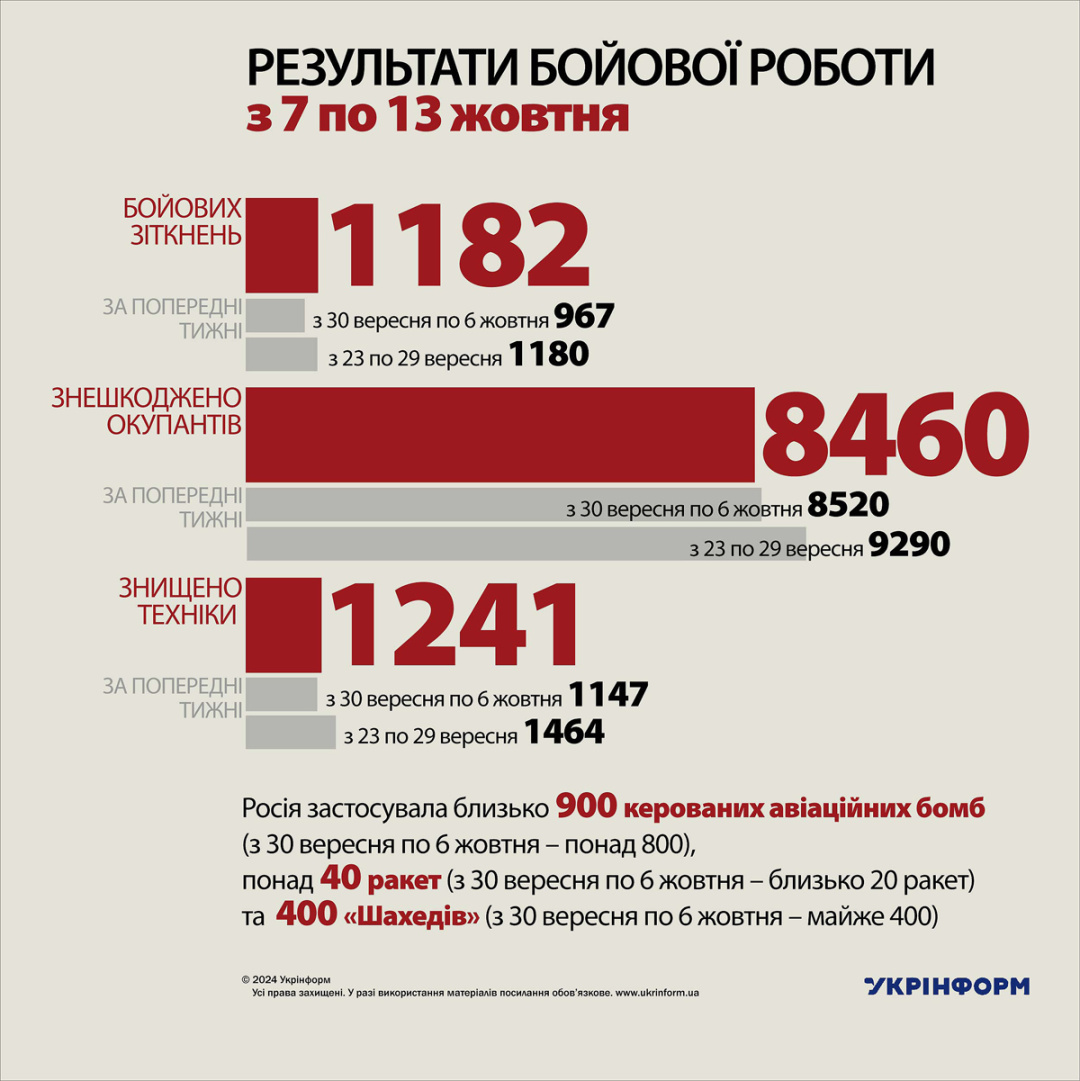
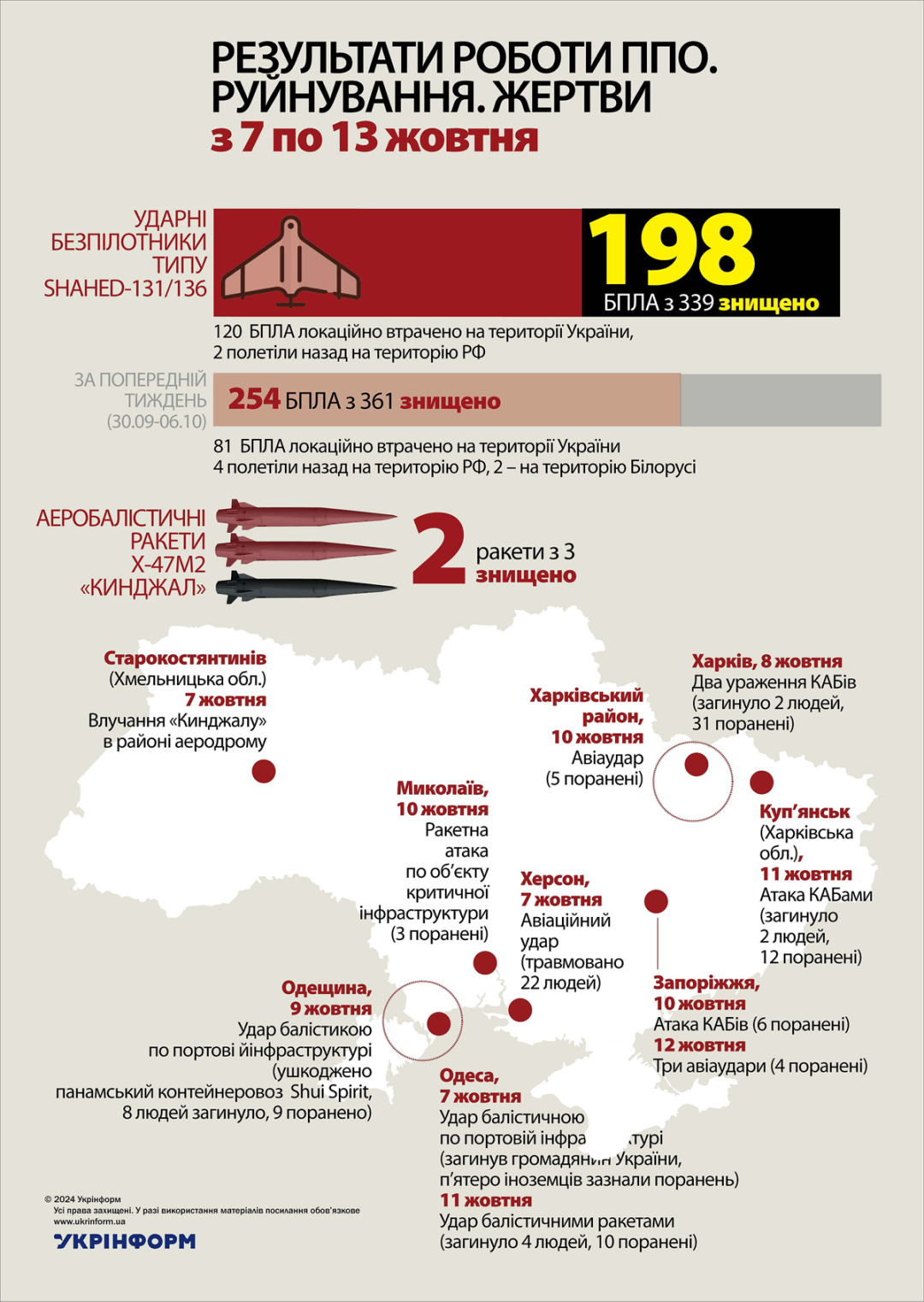
Graphics
WAR AFTERMATH
Human losses. War crimes
In September, at least 208 civilians were killed and 1,220 others injured in the aftermath of Russia’s war of aggression in Ukraine. September saw the record high number of civilian casualties so far in 2024.
Some 49,000 Ukrainian citizens registered as missing by the Unified Register of Persons Who Went Missing under Particular Circumstances (caused by hostilities) are on wanted list.
October 10: Ukrainian journalist Viktoriya Roschyna died in Russian captivity. She went missing on August 3, 2023, while on a tour of Russian occupied Ukraine.
Ukrainian Human Rights Commissioner Dmytro Lubinets:
October 6: reported a new war crime committed by Russian military – the killing of unarmed Ukrainian soldiers who were captured in the settlement of New York, Donetsk region.
October 13: addressed an appeal to international organizations regarding the alleged killing of 9 Ukrainian soldiers who surrendered to captivity in Kursk Oblast.
Reportedly in early October, the Russians tortured to death 45-year-old local resident Volodymyr Zakablyuk, in the Russian occupied city of Kakhovka, Kherson Region.
CULTURE
About 1.7 million artifacts were left in the Russian occupied areas of Ukraine. There is the risk these artefacts can ultimately be taken away to Russia or elsewhere.
ECONOMY
October 5: Russian forces targeted a merchant vessel moored at Pivdenny seaport, with a ballistic missile, and struck another vessel at Odesa on October 7.
St Kitts and Nevis-flagged vessel Paresa was the target of the October 5 attack, and Palau-flagged general cargo vessel Optima was the target of the October 7 attack. Both vessels were hit with Russian Iskander-M ballistic missiles. Oleh Kiper, Governor of Odesa Oblast said that a 60-year-old port worker was killed in the October 7 attack, and five foreign crewmembers sustained injuries. Russia’s Ministry of Defense said it targeted Paresa because the vessel was allegedly delivering ammunition and weapons to Ukraine.
In 2024 so far, Russia has exported over 180,000 tons of stolen Ukrainian grain through the port of Mariupol.
Over the time of the all-out war, Russia targeted energy infrastructure assets run by PrJSC Ukrhydroenergo more than 140 times with missiles, and, on June 6, 2023, Russian military blown up the Kakhovka Hydroelectric Power Plant Dam, causing extensive flooding along the lower Dnieper river.
Over the past three months, Russia deployed nearly 60 attacks on seaport infrastructure, civilian vessels and ships and granaries. The overall aftermath included damage and destruction to some 300 port infrastructure facilities, 177 vehicles and 22 civilian vessels.
Construction of two high-rise apartment buildings for internally displaced persons got underway in Chernivtsi city. The EUR 10.5M project, which will build 144 apartments, will be funded with EU money.
UKRAINIAN HOME FRONT
President Zelensky:
October 9: issued a decree enacting the National Security and Defense Council of Ukraine (NSDCU) resolution to sanction 90 individuals, four legal entities, and 57 companies.
October 12: ordered the Ministry of Defense to ensure the implementation of a new Ukrainian-French model of cooperation that aims to solicit Western investment to significantly expand arms production in Ukraine. “Our industrial capacity allows us to produce far more drones, more projectiles, and military equipment than our country’s financial capabilities allow,” Zelensky said in his nightly video address. The West could provide the money, he said, especially since many partners are currently unable to adequately help Ukraine due to a lack of their own weapons. “Also, some partners have special technologies that can be used in Ukraine right now,” Zelensky said.
Many private manufacturers of heavy weapons and equipment have emerged in Ukraine. For the first time in Ukraine’s history, the private sector has engaged in the production of missiles, Hanna Hvozdiar, the deputy Minister of Strategic Industries said speaking at a defense technology conference in Odesa.
“Over the past year, we have seen a significant increase in private manufacturers of heavy weapons and equipment. For instance, we have become the world leader in the number of artillery systems produced per month,” she said. Ukraine has also seen the emergence of private manufacturers of armored vehicles, with some ramping up production to three units per month. Moreover, there have emerged private manufacturers of missiles, which has never happened before, where there were only state-run manufacturers of missile technologies. Now we have private players on that market, which I consider a significant step forward,” the deputy Minister said.
October 7: Ukraine will not extend its gas transit agreement with Russia after it expires at the end of 2024, Ukrainian Prime Minister Denys Shmyhal told Slovak Prime Minister Robert Fico on Monday. The two held talks in Uzhhorod, which, according to a Ukrainian official, were focused on infrastructure cooperation, energy security and support for Kyiv’s peace plan. “Ukraine once again says it will not continue the transit agreement with Russia after it expires. Ukraine’s strategic goal is to deprive the Kremlin of profits from the sale of hydrocarbons which the aggressor uses to finance the war,” Shmyhal told a news conference at the end of his talks with Fico. The meeting came shortly after Fico’s comments that as long as he is the prime minister, he will block Kyiv’s entry into NATO. Slovakia, a member of NATO and the EU, opposes Kyiv’s accession to NATO, but has a strong interest in maintaining the transit of oil and gas from Russia to the west via Ukraine.
The date for the follow-up Ukraine Peace Summit will not be set until a series of thematic conferences on each point of the Peace Formula are held throughout October. The last such conference will take place on 30-31 October, according to the Presidential Office.
The Verkhovna Rada passed legislations as follows:
on payments to families of captured and missing servicemen;
“On social security of children who suffered from the full-fledge armed aggression by the Russian Federation against Ukraine”;
granted a deferment to draft-eligible men younger than 25 years old who, due to their health status, are recognized as unfit for military service in peacetime, and limitedly fit in wartime;
obliged mass media outlets to insure journalists for the duration of their trips to the war zone;
adopted law to allow foreign citizens and stateless persons to take officer roles within the Armed Forces of Ukraine, the State Special Transport Service of Ukraine, and the National Guard of Ukraine. Previously, foreigners and stateless persons were limited to roles at the enlisted personnel and NCO levels.
Ministry of Foreign Affairs of Ukraine:
condemned the repeated attempts by Georgian leaders to get Ukraine involved in domestic political processes in Georgia ahead of the parliamentary elections due on October 26;
denied manipulative reports by some foreign media outlets alleging that Ukraine is ready to make concessions to the aggressor state at the expense of the country’s sovereignty and territorial integrity.
The Security Service of Ukraine (SBU), in a special operation conducted in a coordinated effort with the Information Security Service (SIB), detained Dmitry Chistilin, a Kremlin’s ideologue of Russia’s armed aggression against Ukraine. Chistilin was extradited from Moldova while trying to return to Russia through the territory of third countries. Chistilin holds double citizenship of Russia and Ukraine. He allegedly repeatedly spoke on behalf of the “Ukrainian public” at various round tables in European countries, trying to weaken Ukraine’s support from Western partners. In Ukraine, Dmitry Chistilin is accused of treason and justification of armed aggression against Ukraine. He faces life imprisonment with confiscation of property he owns.
The Ministry of Culture and Strategic Communications (MCSC) is launching a series of publications about Ukrainian art workers killed by Russia. The series, titled The Shot Generation, will tell about workers of Ukrainian art and culture who died in the aftermath of Russia’s war of aggression against Ukraine.
The lawyers of Vyacheslav Zinchenko, who is a suspect in the murder of Iryna Farion, have appealed to change the preventive measure for their client. However, the Lviv Court of Appeal did not grant the appeal and upheld the previous preventive measure in the form of detention without the right to bail. Iryna Farion – a linguistics professor and divisive hardline campaigner against the use of Russian language – was shot near her house in Lviv on 19 July.
In Odesa Oblast, telecommunication towers are being installed on the border with the self-proclaimed Transnistrian Moldovan Republic to block Russian TV and radio signals. The equipment is currently being tested.
By November 15, regional administrations will have to complete an audit of critical enterprises that received this status from local self-government bodies. The measure is aimed to check the validity of previously made decisions to recognize an enterprise as critical. If an unreasonable decision is revealed, deferments from mobilization for those employees liable for military service may be cancelled.
In 2024 so far, the Defense Ministry Since authorized more than 140 locally produced UAV products and 33 ground robotic platforms for use by the country’s Armed Forces.
October 11: the SBU detained in Kyiv a suspect from Central Asia believed to be affiliated with the Islamic State of Iraq and Syria (ISIS) and was on Interpol’s wanted list during seven years. The SBU said in a press release that the suspect entered Ukraine prior to Russia’s 2022 invasion using false identity and spent time in the Middle East prior, helping transport ISIS recruits to Syria.
ECONOMY AMID WAR
October 10: the Verkhovna Rada voted in second reading for draft law No. 11416-d to amend Ukraine’s Tax Code, introducing new taxation measures during martial law. Starting October 1, this law increases the military tax from 1.5% to 5%, raises the corporate tax on banks’ profits to 50% for 2024, and increases a range of other taxes and fees.
COMMENT. Danylo Hetmantsev, chair of the Verkhovna Rada Committee on Finance, Taxation and Customs Policies: “The legislation on raising taxes adopted by the Verkhovna Rada will add UAH 30 billion in revenues to the State budget by the end of the year. In 2025, state budget revenues from the implementation of this initiative will grow to reach UAH 135 billion.”
In September, Ukraine’s international reserves decreased by 8.1% down to $38.9 billion.
Ukraine will be able to go through the upcoming cold season without power outages if Russia does not attack the critical energy infrastructure facilities that survived previous attacks – Herman Halushchenko, Minister of Energy.
The Japan Bank for International Cooperation signed a loan agreement to set up a credit line totaling up to USD 150 million with the Black Sea Trade and Development Bank (BSTDB). The loan is intended to finance, through BSTDB, the necessary funds for structuring projects to support the reconstruction of Ukraine in sectors such as agriculture, food, transport, logistics, and renewable energy.
Over the past three quarters, JSC “Ukrainian Defense Industry” (UOP) increased its net income by 50% year-on-year.
In Ukraine, VP Atomenergomash , a company affiliated with JSC NAEK Energoatom, has launched production of elements of localizing safety systems for nuclear power plants (NPPs). This important step is aimed at ensuring the safety and sustained operation of nuclear power facilities in Ukraine, which are part of a broader program of the country’s energy independence [from Russia].
Naftogaz Group produced over 11 billion cubic meters of gas over the first nine months of 2024, which is 0.7 billion cubic meters up year-on-year.
In September 2024, Ukraine’s pig iron output amounted to 624,100 mt, down by three percent month on month and up by 28.3 percent year on year, according to the data released by the Ukrainian Steel Association Ukrmetallurgprom. In the given month, the country’s crude steel production declined by 11.7 percent compared to the previous month and rose by 9.3 percent year on year to 610,000 mt, while its rolled steel production came to 503,900 mt, moving down by 14.5 percent month on month and by three percent from the same month last year. Meanwhile, in the first nine months of the current year, Ukraine produced 5.36 million mt of pig iron, up by 21.9 percent year on year, while its crude steel production in the given period totaled 5.88 million, growing by 28.2 percent, and rolled steel production was 4.82 million mt, rising by 22.7 percent, both on year-on-year basis.
ALLIED AND PARTNERS’ AID
President Zelensky paid brief visits to Croatia, UK, France, Italy and Germany that week, held meetings with the Prime Ministers of these countries, NATO Secretary General Mark Rutte, and Pope Francis. The third edition of the “Ukraine – Southeast Europe” summit meeting was held under the chairmanship of the President of Ukraine and the Prime Minister of Croatia. Defense packages for defense, air defense, investments in the production of drones and other weapons are all the results of the visits, Zelensky said on his official Telegram channel.
COMMENT. Oleh Saakyan, policy analyst: “…These meetings will definitely strengthen Ukraine’s diplomatic posture. On a parallel track, we are observing activity by the newly elected NATO Secretary General Mark Rutte, as well as other leaders who are part of the so-called “coalition of the determined”.
Dutch Defence Minister Ruben Brekelmans said on Sunday that his country will invest EUR 400 million (USD 440 million) in advanced drone development programs with Ukraine and deliver more F-16s in the coming months. The drone action plan will combine Ukraine’s innovation and Dutch knowledge to improve technology used on the battlefield, he said. “We will focus on different types of drones, both surveillance drones, more defensive drones, but also the attack drones, because we see that Ukraine needs those more offensive drones also to target military facilities,” Brekelmans said.
Great Britain has committed GBP 3.5 billion (approx. USD 4.5 billion) for Ukraine to purchase modern military equipment from British manufacturers.
The European Commission today took a decisive step in reinforcing support for Ukraine by proposing a comprehensive financial assistance package, consisting of a Ukraine Loan Cooperation Mechanism of up to €45 billion, and an exceptional Macro-Financial Assistance (MFA) loan of up to €35 billion. This package leverages windfall profits from immobilised Russian assets, sending a clear signal that the burden of rebuilding Ukraine will be shouldered by those responsible for its destruction. This approach will be applied for the first time in a structured way and at such a scale across EU and G7 lenders, ensuring long-term, stable financial support for Ukraine’s recovery and resilience. The proposal requires approval by the European Parliament and a qualified majority of EU Member States in the Council before entering into force. In view of the urgency of the proposal, the Commission will be working hand in hand with co-legislators to ensure a swift adoption.
A missile defense base will soon open in Redzikowo, Poland, as part of NATO’s integrated air and missile defense system, Polish Foreign Minister Radosław Sikorski announced on Oct. 13. “In the coming weeks, we will open an anti-missile defense base in Redzikowo near Puck, a facility we agreed upon with the United States,” Sikorski said. He added that during discussions in the U.S., he emphasized the need for the base’s missiles to also intercept Russian missiles targeting Poland, not just Iranian missiles aimed at the U.S.
The Lithuanian government has approved €13 million to support recovery projects in Ukraine. The funds will be directed to the Lithuanian Development Cooperation Fund for humanitarian assistance. Since the inception of Russia’s Russian war, Lithuania has provided Ukraine with nearly €1.5 billion in military, financial, and humanitarian aid.
The US military’s top commander in Europe compiled a list of weapons systems the US possesses that could help Ukraine in its fight against Russia that the Biden administration has not yet provided, including air-to-surface missiles and a secure communications network used by NATO. Gen. Chris Cavoli outlined a list of US capabilities that could help the Ukrainian military fight more effectively. The list included the Joint Air-to-Surface Standoff Missile, a type of air-launched cruise missile, and a communications system known as the Link 16.
Allowing Ukraine to use long-range weapons against targets in Russia is a matter for a particular ally to decide. However, there are all legal grounds for the authorization, NATO Secretary General Mark Rutte said on his visit to Kyiv. “Legally, that is possible, because legally Ukraine is allowed to use its weapons if they can hit targets in Russia, if these targets present a threat to Ukraine. But whether individual allies do that, that’s ultimately up to individual allies,” Rutte said.
October 10: The U.S. Agency for International Development (USAID) announced the expansion of the Agriculture Resilience Initiative-Ukraine (AGRI-Ukraine), attracting nearly $1.75 billion in additional investments for Ukraine’s agricultural sector through nine new partners from the private sector, international financial institutions, and other donors.
The UK is set to launch a new trade sanctions unit with the ability to impose “significant” fines and reporting obligations on banks as part of efforts to halt the export of blacklisted items to Russia. The UK government has introduced a statutory instrument in Parliament, announcing that the Office of Trade Sanctions and Implementation (OTSI) would be fully equipped with enforcement powers by October 10. For the first time, the UK will have a dedicated body for the civil enforcement of trade sanctions, with OTSI able to impose monetary penalties of up to £1mn, or 50% of the estimated value of a breach, whichever is higher.
On October 11, Ukraine’s Minister of Finance Serhii Marchenko signed the Fourth Additional Agreement with the Government of Canada for an additional loan of CAD 400 million (approx. USD 300 million). The funds will be raised through the IMF’s Administered Account. The financing under the Agreement will be used to support priority expenditures of the State Budget of Ukraine.
Nearly 4.2 million non-EU citizens, who fled Ukraine due to Russia’s war of aggression, had temporary protection status in the EU as of August 31.
Defense ministers from NATO member states will begin discussions on reviewing NATO’s relations with Russia during a meeting due in Brussels on 17-18 October.
Polish President Andrzej Duda announced that a key priority of Poland’s EU presidency in the first half of 2025 will be the European integration of Ukraine and maintaining an “open door to Europe” policy for new members.
The Ministry of Defense of Norway has created a new position within its defense attaché office in Kyiv, aiming to bolster cooperation between Norwegian and Ukrainian defense communities and industries.
Slovakia will expand its military base in Michalovce, repairing Ukrainian military equipment instead of supplying new weapons to Ukraine, Slovak Foreign Minister Juraj Blanár said on Oct. 11. Blanár stated that Slovakia will expand the facility as part of its aid to Ukraine, as they will no longer provide Ukraine with military equipment from its stockpiles, given that there is nothing left to offer.
WAR&LIFE
October 8/ Volodymyr Horbulin, senior vice-president of the National Academy of Sciences of Ukraine: Thanks to the latest technologies, nuclear weapons will turn into a military rudiment
QUOTE: “The Russo-Ukrainian war is not yet a war of the future. Rather, it is a war of transition. However, it is that war that formulates new rules and tests new tools.”
October 8/ Air defense soldier: Guys from our mobile units were able to shot down incoming missiles with machine guns.
QUOTE: “Battle glory is not counted separately, but everyone knows what exactly he shot down, and besides, he is constantly learning. Our goal is not to pompously tell who shot down how many missiles, but to ensure that there are no hits. The safety and security of the civilian population is the pride of these guys. They know that they can secure their field position so well that not a single threat will be able to hit it.”
October 9/ Ruslan Myroshnychenko, call sign Santa, the 2nd International Legion commander: When the legion and I arrived in the East, I said: “Guys, you have been preparing for this all your life”.
QUOTE: “The core of the battalion is made up of volunteers, no one will be able to bend them over the knee. Everything must be done consciously, through authority, through trust, because a foreigner came to risk his life for Ukraine, and did it voluntarily. This approach requires constant communication with people. Everyone is a bearer of military experience, and it must be skilfully combined and used.”
October 9/ War in Ukraine: mobilization at 20 years old – necessity or excessity?
QUOTE: “First of all, the army needs infantry, and infantry means high physical exertion. You need to put on a bulletproof vest, take a weapon, a field ration, walk a few kilometers and then go into battle. An average 45-year-old Ukrainian is hardly capable of this.”
October 10/ She passed through Olenivka massacre, a pre-trial detention center in Donetsk and a prison in Mariupol. Inna Semehen, a military chef and a mother of three was in Russian captivity for longer than a year.
QUOTE: “They had lists, our fellow villagers told everything. When they asked if we sheltered soldiers at home, I confessed that I was a military cook on maternity leave. I showed them my military ID. They told me to take my documents, my phone and drive with them to a “police station”. They promised they would just fingerprint me and let me go home by night. But I did not return home that evening, nor the next year.”
Compiled by Maryna Dmytriv, Kyiv
Source: Ukraine Latest: Weekly Digest for October 7-13, 2024

